Skyactiv engulfs new Mazda CX-5
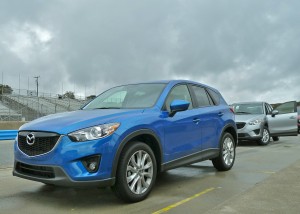
CX-5 styling strategy was done to encase Mazda's Skyactiv engine, drivetrain, aero and design technology.
By John Gilbert
Mazda has established a reputation for building vehicles that range from unusual to mainstream, with all of them sharing a heritage of being enjoyable to drive. With its new CX-5, Mazda may have outdone even its own standards — and the analogy of hitting a home run is noteworthy when nearly all competitors are settling for doubles and triples.
The CX-5 meets the demands of consumers in a struggling economy, who are seeking the seemingly impossible combination of efficient size, cutting-edge technology, safety, fun to drive performance and handling agility, high fuel-economy potential, and high-quality features, while still being available at a reasonable price. After a brief preliminary drive at its introduction, the CX-5 gave no hint of a weakness in any of those categories, all for a price structure starting at $21,000.
Skyactiv was impressive when first unveiled in the Mazda3 in October, although we were told at the time it had to be limited in its totally holistic application, because the full “spaghetti pile” of exhaust manifolds would not fit in the engine bay, and must wait for the next generation Mazda3. It was still an impressive jump, but now we learn the true difference. The CX-5 is the first of what Mazda calls its sixth generation of design concepts, and it was designed to be all-around Skyactiv to house the engine and transmission. The huge manifold fits under the hood, and it gains enough added torque to — suprisingly — outperform the smaller and lighter Mazda3.
Mazda introduced the CX-5 to the auto media at Monterey, Calif., so that we could drive it on Mazda Raceway at Laguna Seca. Driving an SUV, even a compact crossover SUV, on a famous road-racing circuit is a bold venture, but even in a steady rainstorm, the results were impressive. We were advised to stay off the fastest racing line, because the rain would make it slick, but after driving both the front-wheel and all-wheel-drive models for several turns, I felt confident enough to first go through the fast line at every turn, and then go hard through them all. The CX-5 never varied, never leaned, and never threatened to break traction.
It was so good that I asked a top Mazda performance engineer about the difference in lap time between the admittedly quick Mazda3 Skyactiv and the new CX-5 around the twisting Laguna track. He said the difference was 3 seconds — in favor of the CX-5! In road-racing, lap times are differentiated by tenths, and even hundredths, so a difference of 3 seconds a lap might cause the runner-up to withdraw.
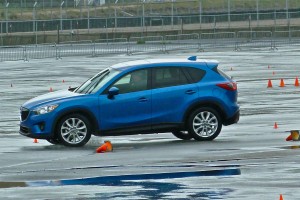
When pushed around a race track, or splashing around an autocross in the rain, the CX-5 was stable and firm.
We later pushed the CX-5s around a well-designed autocross course set up in the puddles of the paddock parking lot. Again, starting cautiously you realized you could take every turn faster, and confidence built quickly.
And this from a CX-5 that has highway fuel economy numbers ranging from 31-35 miles per gallon, depending on the model. My driving partner and I recorded a computerized 31.5 mpg on a stretch where my driving intentions were to evaluate the suspension and agility on the rolling hills and curving roadways inland from Monterey.
The shift from large SUVs to smaller and more fuel-efficient crossovers means manufacturers from all around the world are scurrying to improve their smallest SUVs to grab a slice of the expanding pie. A lot of outstanding vehicles crowd the compact crossover segment, but the common theme is compromise. In seeking more power, sportier handling, more comfortable suspension, interior amenities, safety, and improved real-world fuel-efficiency, providing “most of the above” is commendable. The Mazda CX-5 boasts “all of the above.”
The secret is not the CX-5’s design, or interior, or fun-to-drive suspension — although all of those elements are there — but the all-encompassing assets of Mazda’s new Skyactiv concept with its very impressive Skyactiv engine and purpose-built transmission.
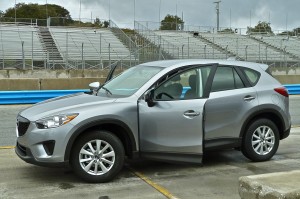
The CX-5 is slightly shorter and narrower than the CX-7, but offers more interior room, power, and performance.
For a starting price point of $21,000, the CX-5 comes with a light but safe high-tensile steel crossover when an all-new engine concept that renders its performance numbers comparatively meaningless, and either a new 6-speed automatic transmission that Mazda insists is superior to either direct-sequential, continuously-variable, or normal automatics, firmer but compliant suspension, steering agility, and fuel economy that goes far enough beyond 30 miles per gallon that Mazda is claiming the best in the segment.
Mazda’s history of innovation is well-chronicled, with rotary engines that work, long-lasting compacts and sedans, and then boldly stepping into the SUV segment, where its large CX-9 won North American Truck of the Year honors when it was introduced. The stylish but more compact CX-7 won the hearts of drivers who recognize Mazda for its “zoom-zoom” quality of always being fun to drive, but it didn’t get great fuel economy with its turbocharged 4-cylinder, although it improved recently by offering a front-wheel-drive version without the turbo. The new CX-5, however, has more interior room than the CX-7, despite being smaller on the outside, and it will eventually replace the CX-7. After thorough engineering to reduce every bit of excess weight, the lightest CX-5 is 288 pounds lighter than the lightest CX-7, and the heaviest CX-5 is 575 pounds lighter than the heaviest CX-7.
Front-wheel-drive, we were told, is not the most efficient for handling, because of the scrub loss on the front tires in aggressive handling. All-wheel drive reduces the scrub loss, but the most efficient point is somewhere between the two. All new suspension geometry and components, and improved steering keep the CX-5 on course with Mazda’s proud handling heritage.
The CX-5 is the first vehicle built with what Mazda will use as its new design strategy. It combines elements of the Kodo, Shinari, and Minagi auto show concept vehicles, moving away from the popular “cab forward” design to escape from looking like either a minivan or large, blocky SUV. Moving the occupants farther rearward allows the front “A” pillar to be moved back and angled more steeply. Sweeping but harmonious contours carved into the side adds to the wholeness of the design by blending into the curvature of the wheel openings and fenders.
In the front, the sixth generation Mazda “face” is directly traceable to the Shinari or Minagi concept cars and veers away from the smiling mouth look of previous generations. North American design director Derek Jenkins explained that a clean sheet for design and engineering allowed him to take some liberties with the design, and still accommodate the distinct needs of engineers. The front may be more bluntly vertical, for example, to provide more room to house the entire Skyactiv engine system, but the styling lines under the new 5-point grille and meeting the headlights on either side create a look of a lower and wider horizontal stance.
CX-5 models start with the Sport in front-wheel drive, moving up to $23,345 in all-wheel drive. Climbing up to the Touring adds content such as 6-way power seats, blind-spot monitoring, 5.8-inch display screen with back-up camera, and 40-20-40 fold-down rear seats, and starts at $23,895 in FWD, or $25,145 in AWD. Top of the line is the Grand Touring, adding things like the 9-speaker Bose audio, power moonroof, 8-way power and heated seats with lumbar adjustment, rain-sensing wipers, leather upholstery, heated door mirrors, and 19-inch wheels, and starts at $27,045 for FWD or $28,295 for AWD.
Unlike the Mazda3, which will be available in the less-expensive existing engine, all CX-5 models are totally built with Skyactiv technology in the 2.0 engine, both transmissions, the chassis and the body, and all-wheel drive is available in all models. Also, both the manual and automatic transmissions are 6-speeds, while some top competitors are still limited to 5-speeds.
All the Japanese companies seemed satisfied over a decade ago with engines capable of hitting 30 mpg, leaving the door open for others to catch up. Hyundai, the upwardly-hurtling South Korean manufacturer, barged through the opening and hasn’t looked back, bypassing many competitors in engine technology, with several gas-direct-injection models capable of reaching or topping 40 mpg.
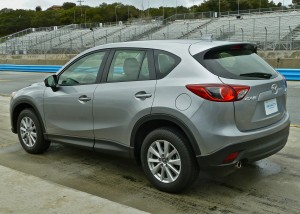
CX-5 switches to cab-rearward design, aligning Skyactiv engine, transmission, body, chassis, suspension, and steering.
Mazda answered the auto-world’s question of which Japanese company would be first to advance to the challenge of making “40 the new 30” for fuel economy when it introduced its new engineering concept called “Skyactiv” in October of 2011. Every detail of the car had been altered, but particularly the engine and transmissions. The new Mazda3, which offers the company’s new holistic engine-transmission-aerodynamic-chassis renovation as an optional upgrade, retained its fun-to-drive character, and instead of reaching 30 miles per gallon as a high point, the Skyactiv version can attain 40 mpg.
Key technical upgrades of the Skyactiv 2.0-liter 4-cylinder are revising the 2.0 to a smaller bore (83.5 cc. from 87.5), longer stroke, Miller-cycle valvetrain technique, with high-pressure direct injection, at 2,900 psi. That improved on the old MZR 2.0’s horsepower, from 148 to 155, and torque, from 135 to 148 foot-pounds. While that doesn’t appear to be overwhelming increases, the torque curve, for example, peaks earlier and stays flatter. The result is a notably quicker Mazda3, with fuel economy estimates improved by 21 percent, to 28 city/40 highway mpg with the newly designed 6-speed automatic, and 18 percent, to 27/39 with the revised 6-speed stick.
The only compromise Mazda engineers had to make was to limit the large, long, and tangled exhaust manifold pipes in order to fit into the existing Mazda3 platform. Until a new Mazda3 redesign, the cars sold in the U.S., Japan and Australia will have a compression ratio improved to 12-to-1, while elsewhere, Mazda’s new 4-2-1 exhaust system with the longer exhaust manifold gives the Slkyactiv a 14:1 compression. There is a significant drop in low-end torque when you take away the much larger exhaust manifold, which eliminates extremely hot exhaust gases more efficiently.
The difference in manifold means the CX-5 and Mazda3 both reach 155 horsepower, and the CX-5 has a very slim 150-148 edge in foot-pounds of torque. That makes it seem the difference is slight, but comparing the actual torque curves shows how misleading the peak difference can be. Both the CX-5 and Mazda3 Skyactiv models are even, at 138 foot-pounds of torque, at 2,500 RPMs, but when the revs climb to 3,000, the CX-5 has climbed steadily to 148 foot-pounds, while the Mazda3 actually dips to 134. The Mazda3 torque then rises steeply to hit its 148 foot-pound peak at 4,000 RPMs, whereas the CX-5 stays above 148 all that time, while rising to 150 at 4,000.
I drove a loaded Grand Touring AWD with the 6-speed automatic and its rev-matching downshiftability, with a $28,295 tag increased by Sirius satellite radio, high-intensity adaptive headlights, keyless entry, and a burglar alarm to a final $30,415. And I also drove extensively in a Sport with FWD, priced at $21,400. A Bose Centerpoint 9-speaker surround sound system with 225 watts, blind-spot monitoring, Bluetooth hands-free technology, and Tom Tom in-dash navigation all are available.
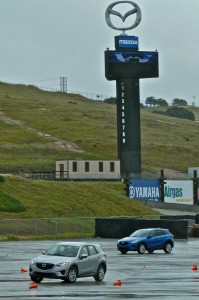
Moderate price, safe structure, potent performance, over-30 mpg make either front- or rear-drive CX-5 a bargain.
My personal wish list would add steering wheel paddle shifters with the automatic, but they aren’t available. Mazda offers a manual gate on the console shifter, which to me is intuitively backwards — push forward to downshift, and pull back to upshift. That’s like racing go-karts, but unlike all the rest of consumer automakers, except for BMW. Good company, perhaps, and at least Mazda offers the very good alternative of a stick shift.
Primary competitors for the CX-5 are the Honda CR-V, and the Nissan Rogue, although the Toyota RAV4, Hyundai Tucson, Kia Sportage, Ford Edge, Ford Escape, Jeep Compass, and others are definitely in the picture. The CX-5 interior features no hard plastic on the upper half of the dashboard, and some neat accents in piano black and satin stainless steel, plus revised instruments and a very solid-feeling steering wheel, and the vastly improved bucket seats are of a much finer grade leather, which means some upscale buyers of Acura RDX, BMW X3, Audi Q3, and Volvo XC-60 might want to take a serious look at the CX-5.
Mazda would welcome the comparisons, and probably would suggest using every criteria, from a road-racing course to a contest to see how many gas stations you pass before needing a refill. It might also dare you to compare interiors. Oh, and it would suggest comparing price stickers, as well.
Comments
Tell me what you're thinking...
and oh, if you want a pic to show with your comment, go get a gravatar!


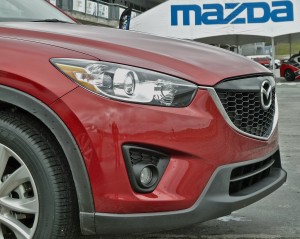
 John Gilbert is a lifetime Minnesotan and career journalist, specializing in cars and sports during and since spending 30 years at the Minneapolis Tribune, now the Star Tribune. More recently, he has continued translating the high-tech world of autos and sharing his passionate insights as a freelance writer/photographer/broadcaster. A member of the prestigious North American Car and Truck of the Year jury since 1993. John can be heard Monday-Friday from 9-11am on 610 KDAL(www.kdal610.com) on the "John Gilbert Show," and writes a column in the Duluth Reader.
John Gilbert is a lifetime Minnesotan and career journalist, specializing in cars and sports during and since spending 30 years at the Minneapolis Tribune, now the Star Tribune. More recently, he has continued translating the high-tech world of autos and sharing his passionate insights as a freelance writer/photographer/broadcaster. A member of the prestigious North American Car and Truck of the Year jury since 1993. John can be heard Monday-Friday from 9-11am on 610 KDAL(www.kdal610.com) on the "John Gilbert Show," and writes a column in the Duluth Reader.